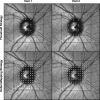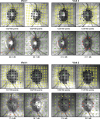Performance of a Defect-Mapping Microperimetry Approach for Characterizing Progressive Changes in Deep Scotomas
- PMID: 31388468
- PMCID: PMC6675515
- DOI: 10.1167/tvst.8.4.16
Performance of a Defect-Mapping Microperimetry Approach for Characterizing Progressive Changes in Deep Scotomas
Abstract
Purpose: To examine whether a microperimetry testing strategy based on quantifying the spatial extent of functional abnormalities (termed "defect-mapping" strategy) could improve the detection of progressive changes in deep scotomas compared to the conventional thresholding strategy.
Methods: A total of 30 healthy participants underwent two microperimetry examinations, each using the defect-mapping and thresholding strategies at the first visit to examine the test-retest variability of each method. Testing was performed using an isotropic stimulus pattern centered on the optic nerve head (ONH), which acted as a model of a deep scotoma. These tests were repeated at a second visit, except using a smaller stimulus pattern and thereby increasing the proportion of test locations falling within the ONH (to simulate the progressive enlargement of a deep scotoma). The extent of change detected between visits relative to measurement variability was compared between the two strategies.
Results: Relative to their effective dynamic ranges, the test-retest variability of the defect-mapping strategy (1.8%) was significantly lower compared to the thresholding strategy (3.3%; P < 0.001). The defect-mapping strategy also captured a significantly greater extent of change between visits relative to variability (-4.70 t-1) compared to the thresholding strategy (2.74 t-1; P < 0.001).
Conclusions: A defect-mapping microperimetry testing strategy shows promise for capturing the progressive enlargement of deep scotomas more effectively than the conventional thresholding strategy.
Translational relevance: Microperimetry testing with the defect-mapping strategy could provide a more accurate clinical trial outcome measure for capturing progressive changes in deep scotomas in eyes with atrophic retinal diseases, warranting further investigations.
Keywords: microperimetry; progression; scotoma; test–retest.
Figures





References
LinkOut - more resources
Full Text Sources

